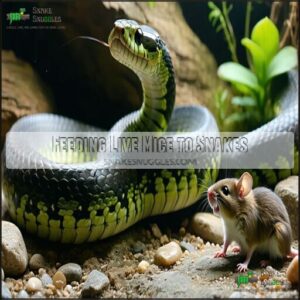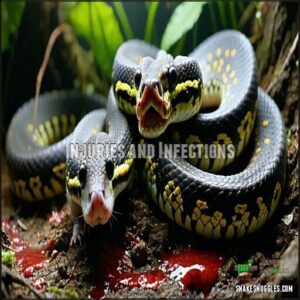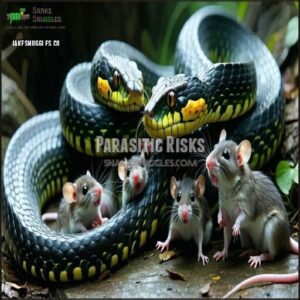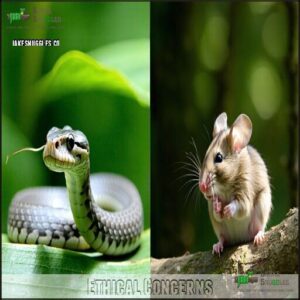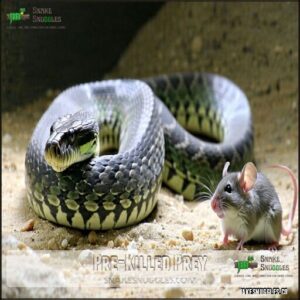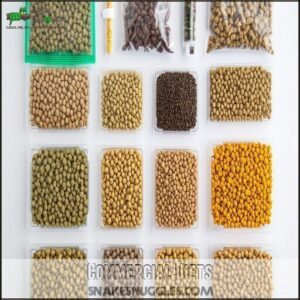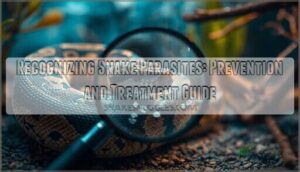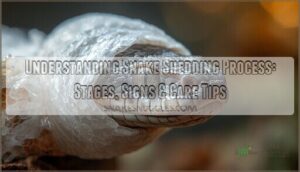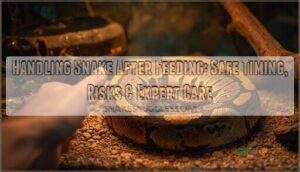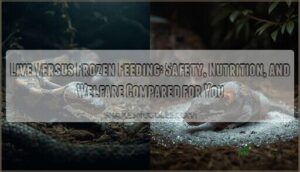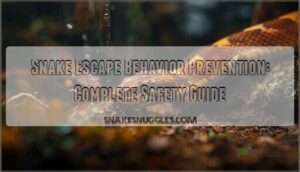This site is supported by our readers. We may earn a commission, at no cost to you, if you purchase through links.
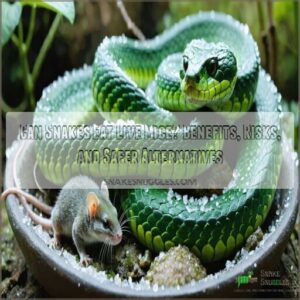
While live prey helps them use natural hunting instincts, it comes with risks. Mice can scratch or bite, which might injure your snake—or worse, stress it out.
There’s also the chance of disease or parasites tagging along with the rodent. Plus, some people find the process unsettling, and it’s even illegal in certain areas.
A safer route is frozen-thawed mice. They’re just as nutritious, easier to manage, and won’t fight back. Switching your snake to this alternative is worth exploring for both their health and your peace of mind.
Table Of Contents
- Key Takeaways
- Feeding Live Mice to Snakes
- Can Snakes Eat Live Mice
- Risks of Live Prey Feeding
- Alternatives to Live Prey
- Transitioning to Safer Feeding Methods
- Frequently Asked Questions (FAQs)
- Do snakes eat mice?
- Can you feed a mouse to a snake?
- Do snakes eat live rodents?
- Should I Feed my snake live or Frozen rodents?
- Are live mice good for snakes?
- Do snakes eat live prey?
- Is it bad to feed live mice to snakes?
- Can I feed my baby ball python live mice?
- Can I feed my corn snake live mice?
- How to monitor a snake eating live prey?
- Conclusion
Key Takeaways
- Feeding live mice to snakes can trigger their natural hunting instincts but poses risks, including bites, infections, and stress.
- Frozen-thawed mice are safer alternatives, offering the same nutrition without the dangers of injury or parasitic diseases.
- Supervise live feeding closely, remove uneaten prey promptly, and inspect your snake for any injuries afterward to prevent complications.
- Transitioning your snake to pre-killed or frozen prey improves safety, convenience, and aligns with humane feeding practices.
Feeding Live Mice to Snakes
Feeding live mice to snakes may seem like the most natural way to replicate their wild diet, and it does offer some notable benefits.
However, it’s important to weigh these advantages against the significant risks and ethical concerns that come with this practice.
Nutritional Benefits
Feeding live mice offers plenty of nutritional benefits for snakes, as they retain denser nutrients compared to frozen ones.
Live mice provide dense nutrients and aid appetite stimulation, promoting natural feeding behavior and improved health for your pet snake.
They also provide a natural diet that aids appetite stimulation and prevents obesity. Live prey offers varied nutrition depending on the mouse’s diet, contributing to ideal snake nutrition.
Disease transmission is a notable risk with live prey.
- Denser nutrients in live prey improve health.
- Supports appetite stimulation, especially for picky eaters.
- A natural diet mimics wild feeding.
- Promotes obesity prevention, aligning portion sizes to instincts.
Behavioral Benefits
Watching a snake chase live prey taps into its instinctual behavior, providing mental stimulation and promoting natural snake behavior.
Moving prey excites predator behavior, boosts appetite stimulation, and encourages exercise promotion.
This hunting behavior mirrors what snakes do in the wild, keeping them active and engaged, think of it as nature’s way of giving your pet a gym session and mental workout.
Natural Hunting Instincts
Natural snake behavior, especially their predatory instincts, thrives on hunting live prey.
Hunting enrichment in captivity allows snakes to express instinctual behavior, mimicking wild hunting.
While Captivity’s impact can dull these instincts, the movement of live prey stimulates natural snake behavior, activating their hunting instincts.
However, it’s also worth asking: is hunting a necessity, or is it simply instinct versus necessity for captive snakes?
Can Snakes Eat Live Mice
Snakes absolutely can eat live mice. It’s how they’ve survived in the wild for millions of years, relying on their hunting instincts to secure prey.
However, when you’re keeping a snake in captivity, this sparks a bigger conversation—the live prey debate. Feeding live mice mirrors natural behavior, letting your snake stalk, strike, and swallow as nature intended, which can enhance its well-being.
On the flip side, animal welfare and snake ethics come into play. While the approach may seem natural, injury prevention becomes a priority. Rodents can fight back, damaging your snake through bites or scratches.
Snake feeding controversies often focus on balancing natural behavior and ethical considerations. Ultimately, watching your snake flourish safely requires mindful decision-making.
Wild mice can introduce dangerous parasites to your pet.
Risks of Live Prey Feeding
Feeding snakes live mice can expose them to serious risks, including painful injuries and infections from rodent bites or scratches.
Live feeding risks injuries, infections, and stress for snakes—safer methods ensure health, safety, and humane care.
You’ll also need to take into account the potential for parasites, stress, and ethical concerns, which make safer alternatives worth exploring.
Injuries and Infections
Rodent bites during live feeding can cause serious snake injuries like scale damage, abscess formation, and severe infections. These wounds, if untreated, may worsen quickly.
To prevent snake infections and complications:
- Monitor live feeding closely for bites.
- Remove uneaten prey after two hours.
- Treat wounds promptly with vet-recommended solutions.
- Use frozen prey to eliminate these risks.
- Inspect your snake for injuries regularly, which can help identify scale damage and other issues early on.
By following these steps, you can minimize the risk of serious snake injuries and ensure the health and well-being of your pet.
Parasitic Risks
Live feeding can expose snakes to parasites, increasing disease risks for both pets and owners.
Zoonotic transmission from live prey introduces threats like Salmonella exposure, Hantavirus concerns, and Leptospirosis risk.
Rodents may carry snake parasites or even fleas linked to plague.
Freezing prey helps reduce parasite transmission, emphasizing the importance of preventive care and safer feeding methods for long-term health, which is crucial for long-term health.
Ethical Concerns
In addition to parasitic risks, ethical concerns around feeding live mice focus on animal suffering and unnecessary cruelty.
Humane treatment aligns with your ethical responsibility as a pet owner.
While wild replication may seem natural, it’s not necessary in captivity.
Humane alternatives, like pre-killed prey, prioritize animal welfare, reducing cruelty while meeting your snake’s dietary needs.
Alternatives to Live Prey
You’ve got safer options than live prey that protect your snake while meeting its nutritional needs.
Frozen-thawed or pre-killed rodents and commercial diets are effective, humane alternatives that eliminate the risks of injury and disease, providing a humane approach to snake care.
Frozen-Thawed Prey
Frozen-thawed prey offers a safe and convenient option for snake feeding.
Proper thawing methods, like using warm water, guarantee nutritional retention and safe handling. Always match prey size to the snake’s widest body part to prevent choking.
Frozen mice and other pre-killed rodents are easy to store, reducing hassle. Quality frozen options are readily available.
With the right storage guidelines, frozen rodents maintain quality and meet dietary needs effortlessly.
Pre-Killed Prey
Switching to pre-killed rodents balances safety with practicality.
These prey options use humane euthanasia, guaranteeing ethical considerations while reducing snake feeding risks.
Frozen mice offer nutritional retention and cost-effectiveness, plus convenient storage for flexibility in feeding schedules.
Nutrient density matters when choosing frozen prey to guarantee your snake gets a balanced diet.
With safe handling, you eliminate injuries to your snake, creating a humane alternative that’s safer, budget-friendly, and protective against unnecessary harm during feeding time.
Commercial Diets
Commercial snake diets, like pellet diets or frozen forms, offer complete nutrition while simplifying snake feeding alternatives.
These options provide owner comfort by eliminating snake feeding risks and the snake feeding controversy often tied to live prey.
For insect-eating species, insect options work well, and many owners source snake diet products from online retailers.
With proper selection, commercial snake diets guarantee your snake thrives, keeping feeding safe, humane, and convenient.
Transitioning to Safer Feeding Methods
Switching your snake from live mice to safer feeding options takes patience and the right approach.
With proper techniques and expert guidance, you can facilitate a smooth shift that benefits both your snake’s health and your peace of mind.
Stimulating Feeding Response
To address snake feeding challenges, try scenting techniques like rubbing prey with chicken broth or reptile skin.
Warming prey to body temperature helps mimic fresh-caught meals. Simulating movement using tongs or forceps feeding stimulates a hunting response.
For stubborn eaters, braining prey (opening the skull slightly) can boost appetite stimulation. These snake feeding tips make switching smoother and safer.
Always sanitize feeding equipment to prevent bacterial growth and ensure a safe feeding environment.
Consulting Experts
When considering safer feeding methods, seeking expert recommendations can ease the process.
Veterinary guidance guarantees snake welfare while avoiding injuries from live prey. Professional advice or community forums often explore snake feeding debates and ethics.
Experienced keepers suggest consulting veterinarians for stubborn eaters or exploring snake feeding discussions for tips. Consider vet products and advice for ideal reptile care.
Keep professional advice handy to avoid mishaps.
Frequently Asked Questions (FAQs)
Do snakes eat mice?
It’s no surprise that snakes eat mice, as they’re a natural part of many snakes’ diets.
Mice provide essential nutrients, and snakes rely on their hunting instincts to capture and consume them in the wild or captivity.
Can you feed a mouse to a snake?
Yes, you can feed a live mouse to a snake, but it’s risky.
Live mice can harm snakes with bites or scratches.
Safer alternatives like frozen-thawed prey reduce injuries while meeting your snake’s nutritional needs.
Do snakes eat live rodents?
Snakes can eat live rodents, mimicking their wild hunting instincts.
However, live prey poses risks, including bites, scratches, and infections.
Supervising feedings or using pre-killed options guarantees safety and eliminates unnecessary suffering for both animals, following their natural wild hunting behavior is not necessary in captivity.
Should I Feed my snake live or Frozen rodents?
Feeding frozen rodents is safer and more humane, reducing risks of injury, infections, and stress for your snake.
Live feeding mimics natural behavior but carries dangers.
Frozen prey provides balanced nutrition and improves handling convenience.
Are live mice good for snakes?
Live mice offer natural nutrients and trigger hunting instincts, keeping your snake active and engaged.
However, they risk injuries and infections.
Weighing benefits and drawbacks helps you decide the safest, healthiest option for feeding.
Do snakes eat live prey?
It’s like watching National Geographic in real life—snakes eat live prey to mimic their natural hunting instincts.
While it’s natural, you’ll need to monitor closely, as it risks injuries, stress, and potential health issues for both animals.
Is it bad to feed live mice to snakes?
Feeding live mice to snakes poses risks like injuries, infections, and stress for both snake and prey.
While it mimics natural hunting, safer alternatives like pre-killed prey offer the same nutrition without the unnecessary danger or cruelty.
Can I feed my baby ball python live mice?
You can feed your baby ball python live mice, but it’s risky.
Live prey might injure or stress the snake.
Safer options, like pre-killed or frozen-thawed mice, eliminate danger while meeting your snake’s nutrition needs.
Can I feed my corn snake live mice?
Jumping back to nature, your corn snake can eat live mice, but it comes with risks like injury or stress.
Supervision is essential, though many recommend frozen-thawed mice for safety, convenience, and reduced prey suffering.
How to monitor a snake eating live prey?
Keep an eye out for rodent bites or scratches during feeding, ensuring the snake strikes quickly.
Always supervise closely, remove uneaten prey promptly, and use tongs if necessary to prevent injuries or excessive stress.
Conclusion
Notably, while snakes can eat live mice, doing so may not be the most practical or safest option for you or them.
Live prey encourages natural hunting instincts, but the risks of injuries, stress, or parasites can outweigh the benefits.
Safer options like frozen-thawed mice provide the same nutrition without the danger, making them a wise alternative.
By understanding your snake’s needs and exploring humane feeding methods, you’ll guarantee their health, safety, and long-term well-being.

